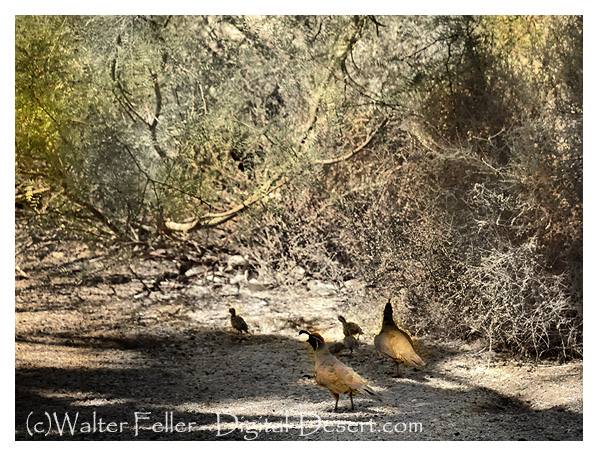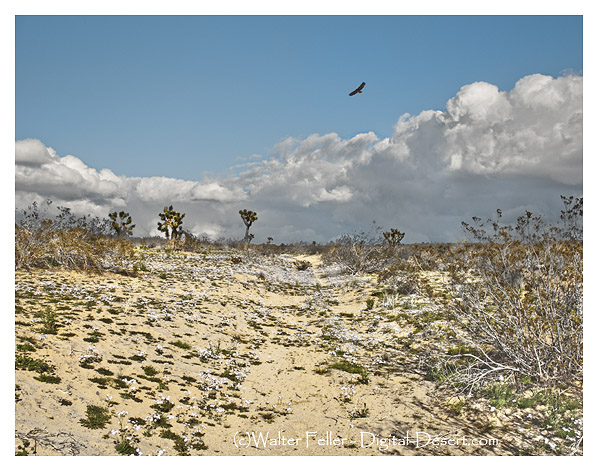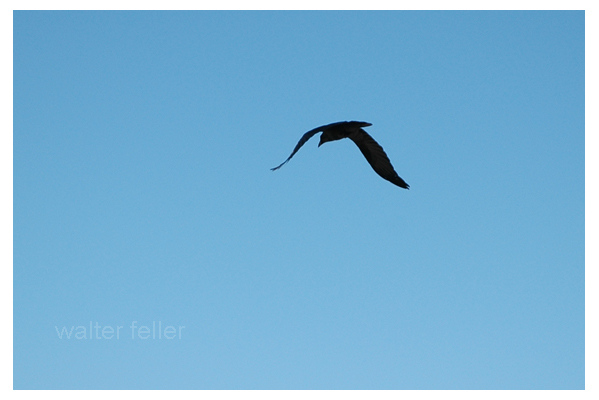Birds
The birds in the Mojave Desert are unique and colorful as were the homesteaders that once staked their claim in this arid land. Regal golden eagles soar in the cobalt desert sky, while a black-crowned night heron preens along the shoreline of Lake Tuendae at Zzyzx. A covey of quail scurry through a desert wash, which, to author Robert Bateman, resemble "ornately costumed Victorian at a banquet."
The character of these birds contradicts the age-old view of the desert as lifeless. They find ingenious ways of escaping the searing summer heat and staying insulated against the bitter winter cold. The Gambel's quail has a body temperature of 107 degrees so it can continue to release heat until the ambient air reaches the same temperature. While this keeps quails from overheating, owls use gular fluttering as a natural cooling system. Owls flap loose skin under their throat. This moves air over their mouth cavities.
Along with adaptations for keeping cool, birds' ability to fly lifts them to higher elevations. This provides them an aerial view of natural water sources at desert springs and seeps, and also at tanks and wells. Biologists believe that for birds, changes in vegetation from upland to riparian are a visual cue for spotting sources of water. Year-round residents learn from their parents where forage and water sources are located.

While some birds glide high above the landscape, others, like roadrunners, stay closer to the ground. The roadrunner uses its zygodactyl feet to run upwards of fifteen miles per hour. Although, you won't see a coyote chasing it, as the famous cartoon would have you believe, you might see a lizard or rattlesnake dangling from its beak. Their featherless scaly legs, an attribute that they share with thrashers and quail, help release heat into the atmosphere. During cold nights, roadrunners enter a state of torpor, slowing their metabolism down to a snail's pace. In the mornings they turn their backs toward the sun, exposing their black pigmented skin which absorbs heat.
Much smaller tha the roadrunner, the Loggerhead shrike also dines on lizards, and pursues its prey with equal vigor. Its method of capturing lizards seems unusually violent and has even earned its nickname "butcher bird." This black-masked predator with its gray cap catches lizards with its sharp beak, and then proceeds to impale them on a thorn or barbed wire fence. Male shrikes give the term being "a good provider" a whole new meaning, impaling more lizards than they can eat to attract potential female mates.
Shrikes are crafty in using their environment to capture prey, while ravens use their resources in very clever ways. Perhaps Edgar Allan Poe saw cunning in their countenance when he described on in The Raven, "And his eyes have all the seeming of a demon's that is dreaming," for these birds use their beaks as scissors and fashion hooks from twigs and rakes from stiff, dead leaves. They carry these tools in their beak, from one place to the next, reusing them if needed. Raven populations have exploded in the Mojave Desert due to an increase in development--you'll see them at most every dumpster. This is bad news for tortoises. Ravens have been teaching their young to feed on tortoise hatchlings.

Ravens are scavengers, and share that trait with turkey vultures. Percieved as unattractive according to societal conventions of beauty, the turkey vultures' bald heads are highly practical for feeding on dead carrion. Having a featherless head prevents vultures from contracting diseases and also helps to dissipate heat. Along with a bald head, turkey vultures get relief from the heat in a unique way. They urinate on their chicken-like legs which absorb the waste, and provide a source of evaporative cooling.
Although some people might view the desert as devoid of life, for many birds, it is their lifeblood. The next time you're in the Mojave, pull over and scan the surrounding desert with your eyes and ears. Watch for a great-horned owl perched on a Joshua tree. Listen for the guttural "kerr" of a hawk or the raucous call of a jay. The Mojave Desert is truly for the birds.
Adapted from: The Mojave Desert is for the Birds - Hilary Clark, NPS
American Coot
American Kestrel
Ash-throated Flycatcher
Barn Owl
Belted Kingfisher
Black-crowned Night Heron
Black-headed Grosbeak
Black-throated Sparrow
Brown-crested Flycatcher
Burrowing Owl
Cactus Wren
Canada Goose
Cattle Egret
Clark's Grebe
Common Yellowthroat
Cooper's Hawk
Costa's Hummingbird
Double-crested Cormorant
Gambel's Quail
Golden Eagle
Great Blue Heron
Greater Roadrunner
Great Horned Owl
Great-tailed Grackle
Golden Eagle
Hermit Warbler
House Finch
Killdeer
Ladder-backed Woodpecker
Lawrence's Goldfinch
Loggerhead Shrike
Mourning Dove
Northern Flicker
Phainopepla
Pied-billed Grebe
Pinyon Jay
Prairie Falcon
Raven
Red-tailed Hawk
Ruby-crowned Kinglet
Summer Tanager
Swainson's Hawk
Townsend's Warbler
Verdin
Vermilion Flycatcher
Western Grebe
Western Tanager
White-faced Ibis
Wilson's Warbler
Western Screech-Owl
Western Scrub-Jay
Other:
Raptors
